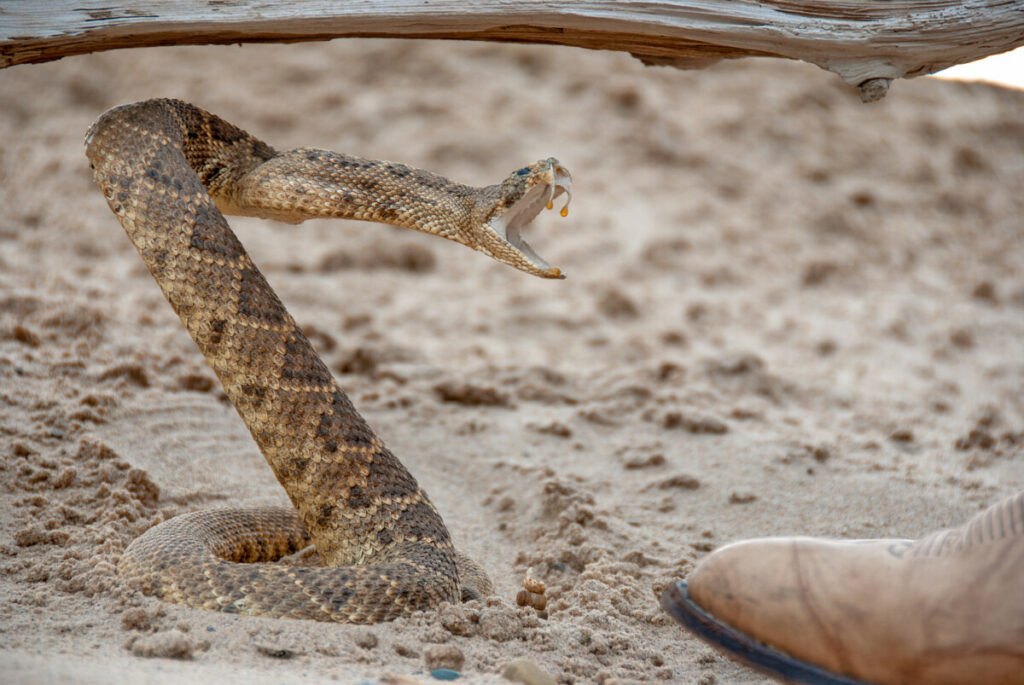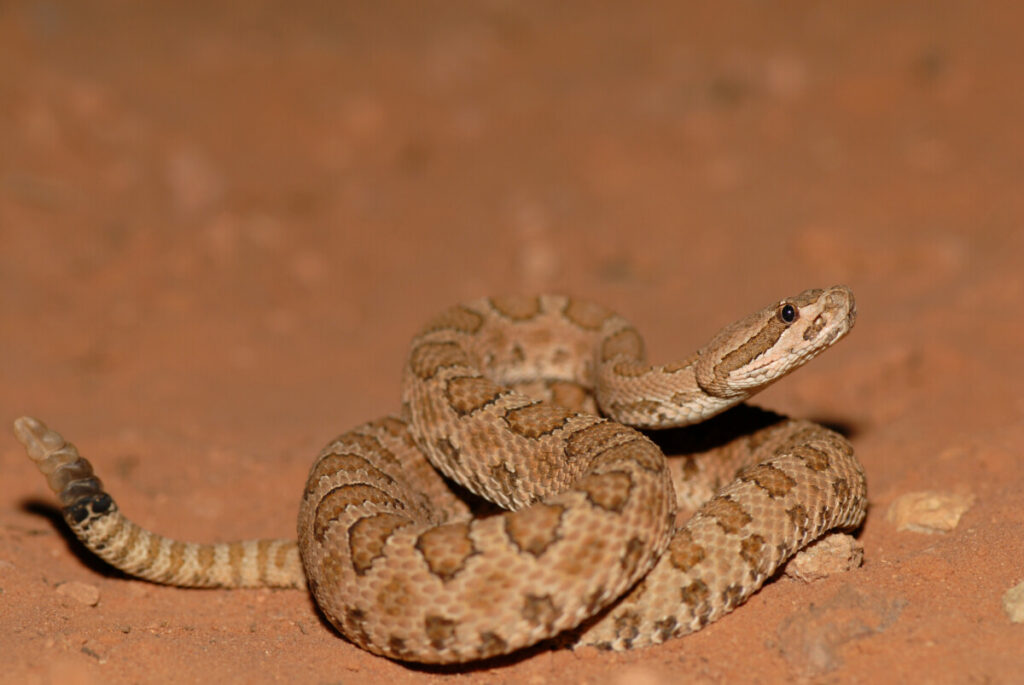
Not to many people want to come across a venomous snake in the wild. When it comes to rattlesnakes, something that they are known for is coiling and striking. However, can a rattlesnake strike if not coiled up first?
A rattlesnake can and will strike if not coiled if the target is within biting distance. While rattlesnakes coil to strike over distances, they can and will strike from other positions as well. An uncoiled, silent rattlesnake is not necessarily unaware of a hiker’s presence and can still strike.
So, what is a safe distance to be from a rattlesnake in the wild? What does a rattlesnake’s position mean about its current temperament? More information that will help you answer those questions is below.
Why Do Rattlesnakes Coil Before Striking?
Like any animal, a rattlesnake can bite you from any position it pleases if it feels threatened. If it can turn its head enough to get its fangs around any part of you, it will not hesitate to bite.
However, a bite is not the same as a strike. Nevertheless, an uncoiled rattler can still strike at you, if only less effectively.
Rattlesnakes, like other wild animals, use their body language to communicate with strangers, in addition to their signature rattle. While rattlesnakes do coil before striking, there is more than one type of coil. A rattlesnake at peace might coil itself into a round ball, otherwise known as a resting coil.
From this position, it would be difficult for the snake to strike over any kind of distance. The position is more suited to absorbing heat from the sun.
In order to strike, it would need to first uncoil itself as it struck, limiting the accuracy with which it could deliver a blow. If you see a rattlesnake in this type of coil, you are likely safe, but you should still stay away from it to ensure your safety.
A Rattlesnake’s S Coil Or Striking Position
On the other hand, an irritated or threatened rattlesnake may coil itself into an “S coil” or striking position. From this position, tail tucked close to the ground for balance and body curved for optimal power and control, a rattlesnake can deliver the most accurate and effective bite.
A rattlesnake can leap out half its body distance in a bite from this position. It is also able to still move backward, away from potential danger, in this position. In essence, a rattlesnake in an “S coil” is most likely about to strike, or at the very least is very agitated.
Because of its tendency to coil into the striking position before biting most times— as discussed, in order to maintain control and the ability to get away— people have formed the assumption that it cannot strike from any other position.
This is not the case. It is simply that the rattlesnake knows this to be the most effective way of protecting itself.
How Can You Tell if a Rattlesnake is Going to Strike?

In order to tell whether or not a rattlesnake is going to strike, listen for its rattle. A snake coiled in a striking position that is actively using its rattle to warn you off is probably preparing to lash out and bite you.
However, a quiet snake does not mean the snake is safe to be around. Young rattlesnakes with underdeveloped rattles may not be able to rattle yet, and other snakes only rattle for a short time before striking. Also, a rattlesnake doesn’t always rattle its tail before striking.
Striking from a round coil is not as accurate, but is fully possible for a rattlesnake. It will take a few seconds longer to get into a position from which it can safely do this though.
If this is the case, back away from the snake before it has the chance to strike. The best-case scenario is that it goes into “retreat mode.”
A Rattlesnakes Would Rather Retreat Than Strike
A snake that is in retreat mode is fully stretched out, in the act of escaping, and will only bite if someone or something walks directly into its path. Rattlesnakes are most vulnerable from this position.
In order to strike, it would need to first coil itself to get within biting range safely before making an escape.
Rattlesnakes tend to freeze in place when approached by a larger creature, but they will absolutely still bite if you get close enough. Contrary to what you might think rattlesnakes are not overtly aggressive towards humans.
A rattlesnake would probably rather get away unnoticed than have a confrontation with you. Just be cautious and respectful when in areas where you know rattlesnakes are common.
If you find yourself close to a rattlesnake, move away from it quickly and carefully. A rattlesnake that is not coiled may not be able to strike over the same large distances it could when coiled, but it can very much still bite you.
Rattlesnakes like tall grass and heavy underbrush, so avoid these areas when hiking. They can also swim, so carefully inspect “branches” or “sticks” in rivers or lakes before grabbing them.
How Far Can A Coiled Rattlesnakes Strike?
So how far can a coiled rattlesnake strike? A rattlesnake can deliver a strike around half its body length, though the exact distance of each strike depends on the snake, its position, and its body temperature.
Some estimates say that a snake can strike up to three-quarters of its body length from the striking position. However, most agree that such large striking ranges are uncommon.
Still, it is best not to give yourself too much credit for your snake-length estimating skills. An adult rattlesnake can be anywhere between 3 and 6 feet long. Some can even reach lengths of over 8 feet.
Rattlesnakes on the larger end of the scale can launch themselves around 4 feet in distance, with younger or smaller rattlesnakes reaching only around 1 foot in distance.
Either way, you should not be this close to a rattlesnake. Keep as much distance as you can with a rattlesnake if you encounter one in the wild. This will give it space to flee and should have no need to strike.
If you do get bitten by a rattlesnake, don’t panic! Though snakebites should certainly be considered medical emergencies, a healthy adult is unlikely to die from a snake bite unless they are many hours away from civilization and a hospital.
Keep the affected area below heart level and try to keep it as still as possible. Get to a hospital as quickly as you can so anti-venom can be administered.
